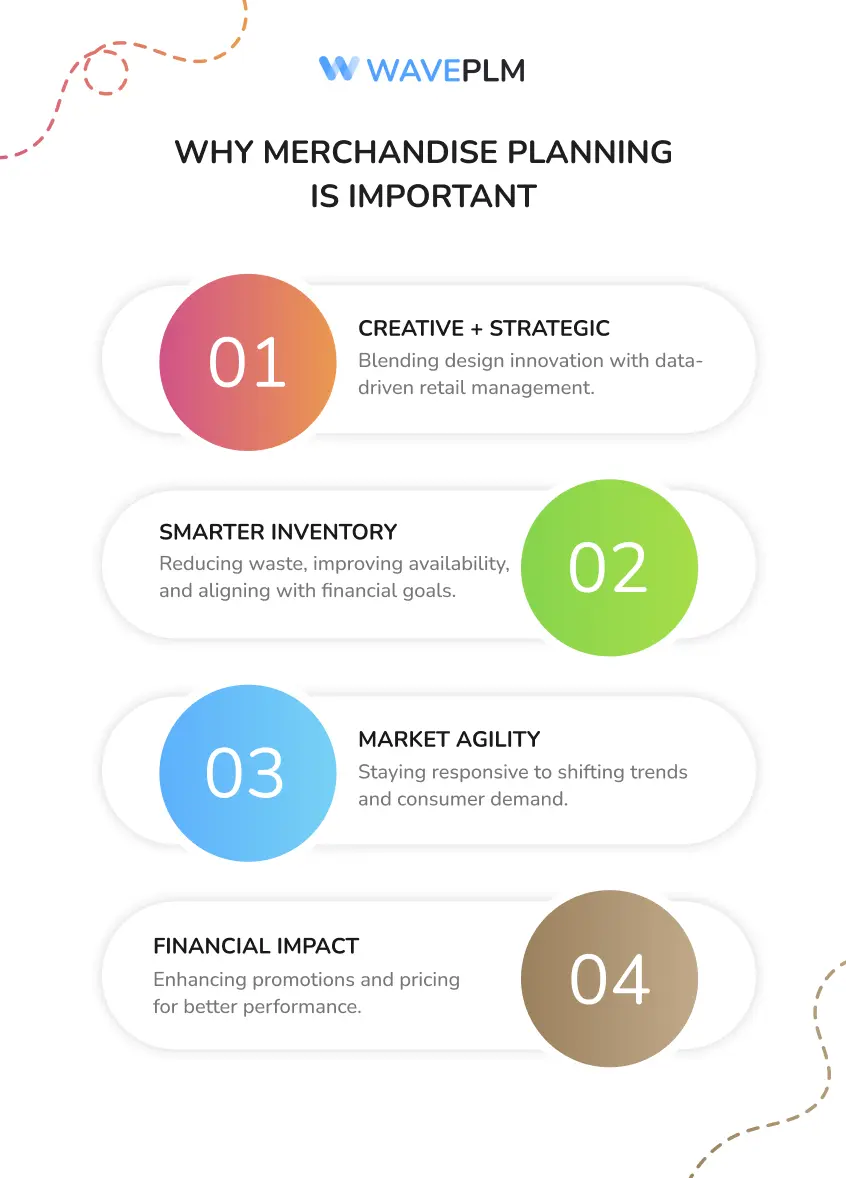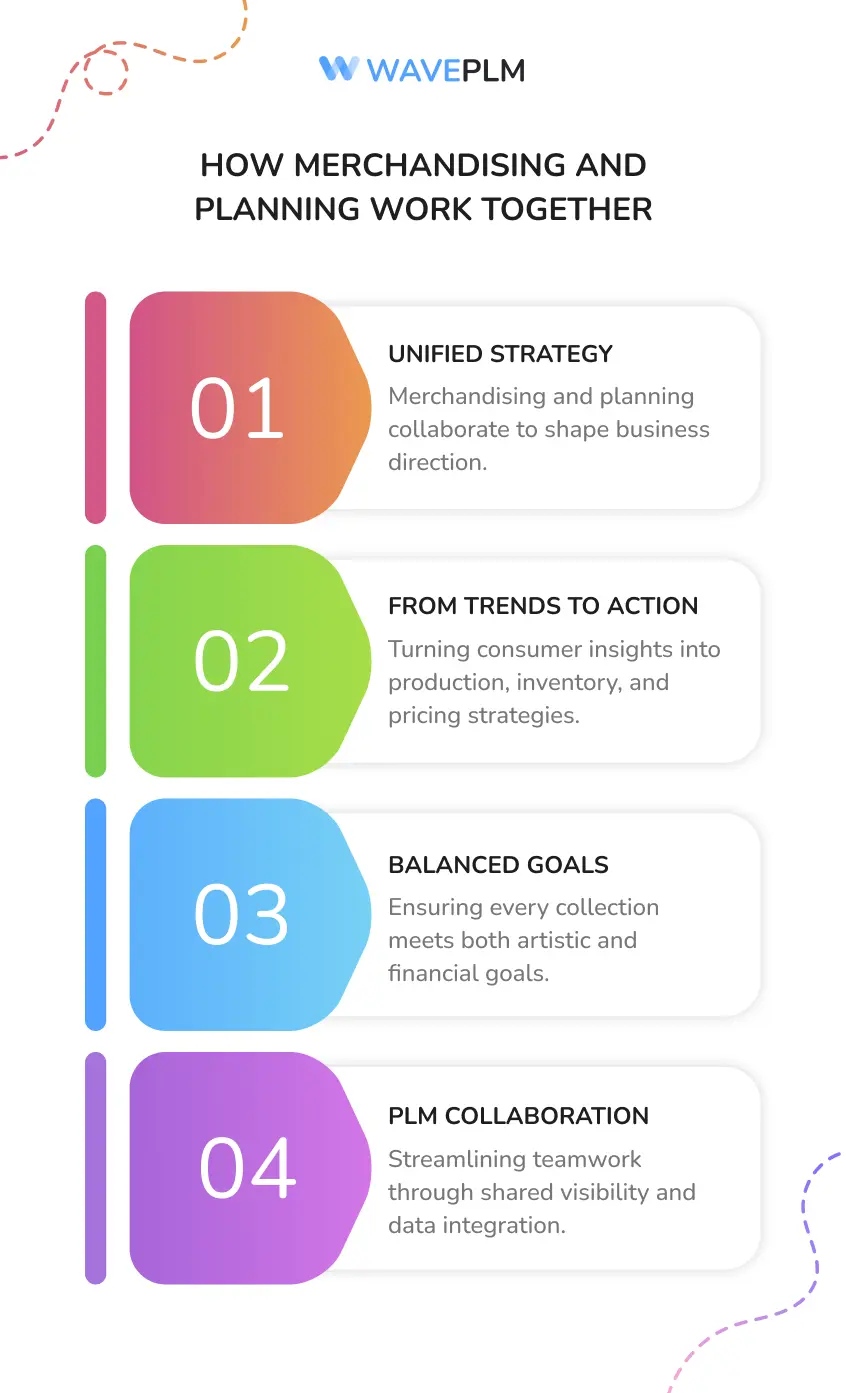
Introduction: Why Merchandising and Planning Matter in Fashion
Every successful fashion brand begins its story not on the runway, but in the planning room. Merchandising and planning act as the foundation for every profitable collection, guiding decisions that balance creativity with commercial results. Before designers cut fabric or finalize sketches, teams create a clear merchandise plan that connects creative energy to business strategy. This process helps brands predict customer demand, adjust to market trends, and ensure their inventory supports both design goals and financial success.
A strong merch plan becomes the compass that keeps a retail business on course. Behind every top-selling garment is a plan that integrates design innovation with accurate demand forecasting, solid financial planning, and precise inventory management. The most successful fashion companies recognize that artistic direction alone is not enough — real success comes from blending creativity with measurable planning outcomes that meet customer expectations and deliver profit.
Merchandising and planning define how a brand operates from concept to consumer. They shape the decisions that influence what products hit the market, when they appear, and how customers perceive them. This alignment drives sales performance and brand reputation while creating a competitive edge in the fast-moving retail industry.
What Is Merchandise Planning?
Merchandise planning is a strategic process that ensures a retailer has the right products, in the right quantities, at the right time, and at the right price. It involves analyzing past sales, forecasting consumer behavior, and planning assortments that meet customer demand without creating excess inventory. It also supports financial success by aligning sales targets with inventory investments and operational efficiency.
The merchandise planning process involves several interconnected stages that help planners anticipate demand, optimize stock levels, and achieve financial objectives. By using historical data, sales patterns, and consumer trends, companies can make smarter decisions that lead to higher customer satisfaction and reduced waste.
In essence, merchandising determines what to sell, while planning determines how, when, and where to sell it. Together, they create a comprehensive merchandising strategy that keeps the retail business agile and profitable.
|
Merchandising |
Planning |
|---|---|
|
Defines product categories, style direction, and creative vision |
Determines budget allocations, production timelines, and distribution schedules |
|
Focuses on product design and assortment planning |
Ensures alignment with financial objectives and cash flow management |
|
Responds to consumer preferences and market trends |
Builds structure through data analysis and forecasting demand |
Key Elements of a Merchandise Plan
A merchandise plan serves as both a creative and financial roadmap. It ensures a company’s product assortment meets customer expectations while maintaining profit margins and controlling costs. A well-designed plan includes seven essential elements that drive overall retail performance:
|
Element |
Description |
|
Sales and Inventory Forecasting |
Uses historical sales data and consumer trends to anticipate future performance |
|
Assortment Planning |
Selects styles, colors, and sizes that reflect customer behavior and market demand |
|
Pricing Strategies |
Determines right price points and applies assortment planning to balance customer value and profit margins |
|
Inventory Planning |
Optimizes inventory levels to maintain availability without overstocking, which can be effectively managed by setting the appropriate retail price |
|
Open-to-Buy Budgets |
Manages inventory investments and maintains cash flow control |
|
Allocation Planning |
Distributes products strategically by region, store type, and channel |
|
Post Season Analysis |
Compares actual sales to forecasts to improve the next season’s results |
These elements form the core of every effective merchandise planning strategy. Together, they help teams set realistic sales targets, anticipate demand, and adapt to changing conditions in the retail market.
Why Merchandise Planning Is Important
Merchandise planning is important because it connects the art of design with the science of retail management. It ensures every product serves a business purpose, aligns with financial goals, and fulfills customer demand. Without structured planning, even the most creative collections risk missing market opportunities or accumulating excess inventory.
This process also strengthens inventory management by minimizing waste and improving product availability. A well-executed merchandise financial planning strategy helps brands align their inventory investments with long-term financial goals, maintain profitability, and adapt quickly to external factors such as consumer trends and market demand.
Additionally, effective planning enhances promotions strategically, ensuring retailers can influence demand through pricing adjustments or targeted campaigns. It improves overall financial performance and enables business leaders to make proactive rather than reactive decisions.

The Role of PLM Software in Merchandise Planning
Product Lifecycle Management (PLM) software has revolutionized how modern fashion companies approach merchandising and planning. By centralizing all product data – from design sketches and material sourcing to cost analysis and production status – PLM provides a unified platform for decision-making. It enables teams to track every step of the planning process, improving accuracy and collaboration.
How PLM Enhances Merchandise Planning Efforts
|
Function |
Benefit |
|
Connects creative teams with costing and sourcing information for better planning |
|
|
Demand Forecasting |
Uses historical sales data and AI tools to forecast customer demand and anticipate market trends |
|
Cross-Team Collaboration |
Unites designers, planners, and merchandisers to align creative and financial goals |
|
Scenario Planning |
Allows simulation of multiple demand outcomes to reduce risk and enhance inventory optimization |
|
Performance Monitoring |
Provides visibility into sales performance, product lifecycle, and profit margins |
PLM tools also streamline communication across supply chains. By integrating financial planning with design development and production scheduling, brands gain real-time insights that guide smarter decision-making. The result is faster turnaround times, fewer errors, and improved overall financial success.

How Merchandising and Planning Work Together
Merchandising and planning work hand in hand to shape the direction of a fashion business. Merchandising focuses on creating and curating the right product mix, while planning ensures those products reach the market efficiently and profitably. This partnership is crucial to aligning creative ambitions with realistic financial outcomes.
When these two functions operate together, they create a dynamic feedback loop:
- Merchandising identifies emerging consumer trends and defines what products to offer.
- Planning translates those insights into production schedules, inventory allocations, and pricing strategies.
- Together, they ensure that every collection meets both artistic goals and financial objectives.
In a data-driven environment, this collaboration thrives within PLM systems. Teams gain shared visibility into assortment plans, production milestones, and inventory movements. The result is a streamlined process where creative teams innovate confidently while financial planners manage profitability with precision.

Digital Transformation in Merchandise Planning
The digital transformation of merchandise planning has introduced a new era of data-driven retail. Modern merchandise planning software, powered by PLM platforms and cloud technology, helps brands analyze historical data, track sales performance, and respond instantly to market fluctuations. It gives retailers a live view of their planning process, ensuring decisions are always based on accurate, up-to-date information.
Instead of relying on spreadsheets, teams now use AI-driven tools for forecasting demand, managing inventory, and monitoring cash flow. They can conduct scenario planning to prepare for multiple outcomes—whether predicting seasonal trends, testing new pricing strategies, or simulating supply chain changes.
Benefits of Digital Merchandise Planning
|
Benefit |
Description |
|
Smarter Forecasting |
Combines sales data with predictive analytics for accurate projections |
|
Optimized Inventory Management |
Reduces waste, balances inventory levels, and ensures product availability |
|
Collaborative Workflow |
Connects departments in real time for faster decision-making |
|
Enhanced Financial Planning |
Aligns budgets, profit margins, and financial goals across teams |
|
Improved Responsiveness |
Enables brands to adjust quickly to consumer behavior and external factors |
With these tools, fashion businesses can anticipate demand more effectively, control their supply chain, and improve their overall financial performance. This evolution marks a shift from reactive to predictive management in the retail industry.
The Merchandise Planning Process Template
A structured approach to merchandise planning helps brands maintain efficiency and consistency. Below is an expanded framework for building a comprehensive merchandise planning strategy:
|
Stage |
Objective |
Key Actions |
|
1. Analyze Historical Sales Data |
Identify what worked and what didn’t |
Study historical sales, post season analysis, and previous sales season trends |
|
2. Evaluate Market Trends |
Understand shifts in consumer preferences |
Monitor consumer behavior, competitor actions, and external factors affecting market demand |
|
3. Set Financial Targets |
Establish measurable goals |
Define financial objectives, cash flow limits, and overall financial success benchmarks |
|
4. Create an Assortment Plan |
Align creativity with demand |
Balance style innovation with customer demand using historical data and forecasting models |
|
5. Develop Pricing Strategies |
Define right price points for profitability |
Use data-driven insights to set margins, offer promotions strategically, and influence demand |
|
6. Execute and Allocate |
Deliver products efficiently |
Coordinate with supply chain partners to distribute inventory across sales channels and retail stores |
|
7. Monitor and Adjust |
Ensure adaptability |
Use real-time reports from PLM dashboards to refine inventory planning and adjust production timelines |
|
8. Conduct Post Season Analysis |
Drive continuous improvement |
Compare forecasted and actual sales, identify gaps, and implement learnings into the next cycle |
This systematic process ensures every stage of merchandise planning contributes to better financial outcomes and long-term brand growth.
The Future of Retail Merchandise Planning
The future of retail merchandise planning will continue to evolve alongside technology. Artificial intelligence, predictive analytics, and integrated PLM platforms will define how brands plan, forecast, and execute merchandising strategies. Companies will use real-time insights from sales channels, both online and in physical stores, to refine their merchandise planning efforts continuously.
Sustainability will also become a central pillar of merchandise planning strategies. By analyzing historical sales and forecasting demand more accurately, brands can avoid overproduction, reduce waste, and make smarter inventory investments. This approach not only improves cash flow but also supports global sustainability goals.
As customer behavior shifts rapidly, brands that embrace innovation and digital transformation will stay ahead of competition. A forward-thinking merchandise planning strategy enables retailers to develop products that align with consumer demand, financial planning, and operational efficiency.
Conclusion: Smarter Planning, Better Merchandising
Merchandising and planning are the engines that power every successful retail business. With modern PLM software, merchandise planning becomes a precise, data-driven process that blends creativity, financial control, and strategic foresight.
By implementing an effective merchandise planning process, fashion brands can develop strategies that anticipate demand, manage inventory intelligently, and achieve consistent profitability. The combination of strong planning and technology ensures that every design decision aligns with financial performance, customer demand, and long-term business growth.
In an era defined by rapid consumer shifts and fierce competition, the brands that thrive will be those that combine creative brilliance with data-driven planning. Smarter merchandise planning not only strengthens financial success—it builds the future of retail.





Leave a Reply